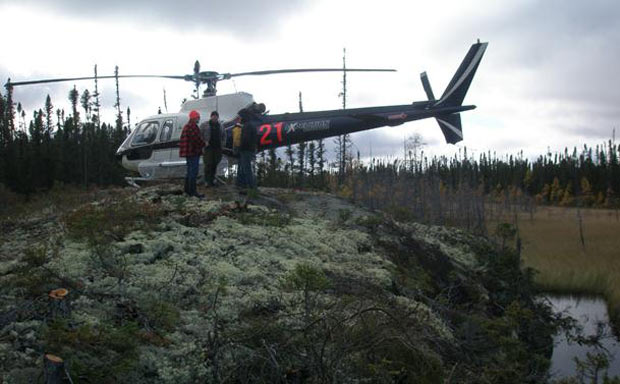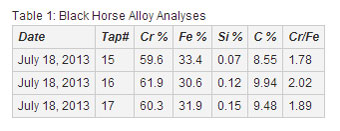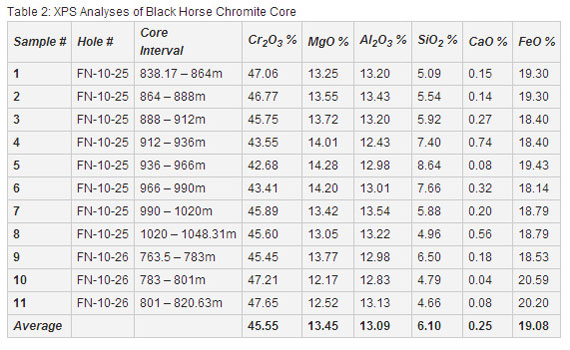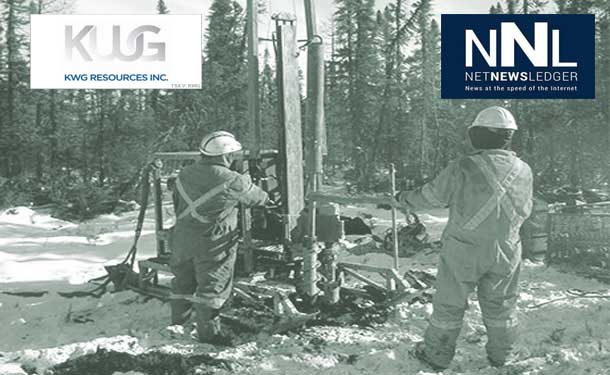
 TORONTO – KWG Resources Inc. (“KWG”) has announced that a continuous pilot smelting campaign on Black Horse chromite drill core has been successfully completed with excellent results. A bulk sample comprised of 1186 kilograms of drill core collected from two holes drilled in 2010 was used for the test.
TORONTO – KWG Resources Inc. (“KWG”) has announced that a continuous pilot smelting campaign on Black Horse chromite drill core has been successfully completed with excellent results. A bulk sample comprised of 1186 kilograms of drill core collected from two holes drilled in 2010 was used for the test.
Black Horse mineralized width increased to 109.91 meters
When the Black Horse discovery was made, Fancamp Exploration Ltd. (“Fancamp”) reported hole FN-10-26 to include an intersection of massive chromite from 763.5 meters down the hole, through to 820.63 meters in the hole. The combined intersection was reported as massive chromite at an average grade of 45.04% Cr2O3. In preparing this drill core for the metallurgical test, the analysis of adjacent core that was not previously assayed, discovered that the mineralization commenced 53.26 meters further up the hole. This core has now been completely sampled and documents that this 53.26 meter intercept contains four intervals dominated by massive chromite, from 710.72 to 719.72 metres, 728.74 to 739.79 metres, 744.82 to 749.41 metres and 756.86 to 762.35 metres. The weighted average percentages of Cr2O3 of these four intervals are 40.58, 33.30, 41.46 and 44.08 respectively.
Smelting results in easy reduction and high metal recoveries
In a report released August 13, 2013 XPS Consulting & Test Work Services based in Sudbury, Ontario advised: “The Black Horse chromite ore smelts readily and produces both a high grade alloy and low Cr values in the discard slag. The results demonstrated that the high grade ore tested results in a high alloy grade and Cr recoveries above 95%, higher than typical commercial chromium operations.”
The key objective of this brief campaign was to demonstrate, by making optimum use of the limited amount of sample material, that Black Horse massive chromite can produce similar metallurgical results to ores more exhaustively tested. The material was smelted at the conclusion of a recent larger scale chromite ore smelting test campaign, without any interruptions in processing, at a time when the furnace was operating under very stable conditions. The results confirmed that very high chromium recoveries averaging 95% can be achieved, producing ferrochrome alloy grades of 60-62% chromium. The test demonstrated that Black Horse massive chromite can be efficiently smelted in a DC furnace using moderate flux and reductant additions and manageable operating temperatures. Moe Lavigne, KWG VP of Exploration & Development stated, “ These are the highest grade ferrochrome results we’ve seen from Ring of Fire chromites.“

The second and third metal tap (#16 and #17) best reflects the composition of ferrochromium produced from pure Black Horse ore. The first metal tap (#15) included a contribution of furnace metal heel from a previous XPS campaign.
The Black Horse chromite was discovered by Fancamp on their Koper Lake property in 2010. KWG has an option to earn an 80% interest in chromite in this property. Core boxes containing drill core from holes FN-10-25 and FN-10-26 were extracted from storage at Koper Lake and delivered to XPS’s testing facilities at Falconbridge, Ontario. Prior to delivery, the core was photographed and analysed with a portable XRF. This core had been only partially sampled at regular intervals by Fancamp in 2010. In order to deliver the minimum quantity of sample material needed to perform the melt test, the entirety of the remaining core was crushed in batches representing the 11 core intervals listed in Table 2 below which reports the XPS analysis derived from a sub-sample from each homogenized batch.

The average grade of 45.55% Cr2O3 of the material tested by XPS is a sample of pure massive chromite, but is a grade that could be achieved as a result of beneficiation of run of mine recoveries and is not representative of a potential resource grade. The average assay produced by selective sampling by Fancamp in 2010 of 43.49% Cr2O3 for hole FN-10-25 and 45.04% Cr2O3 for hole FN-10-26 is more representative of the grade of potential run of mine recoveries. Fancamp’s results are consistent with the average results of the continuous tightly spaced analyses with a Niton portable XRF. The Niton results, calibrated against the Fancamp assays performed by Actlabs, are 43.3% Cr2O3 for hole FN-10-25 and 44.55% Cr2O3 for hole FN-10-26.








